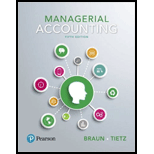
Managerial Accounting, Student Value Edition Plus MyLab Accounting with Pearson eText -- Access Card Package (5th Edition)
5th Edition
ISBN: 9780134642093
Author: Karen W. Braun, Wendy M. Tietz
Publisher: PEARSON
expand_more
expand_more
format_list_bulleted
Question
Chapter 13, Problem 2QC
To determine
To identify: The activity which include the transactions that affect long-term liabilities and
Expert Solution & Answer
Want to see the full answer?
Check out a sample textbook solution
Students have asked these similar questions
Which principle requires that revenues be recorded when earned, not when cash is received?
A) Matching PrincipleB) Conservatism PrincipleC) Revenue Recognition PrincipleD) Historical Cost Principlecorr
Which principle requires that revenues be recorded when earned, not when cash is received?
A) Matching PrincipleB) Conservatism PrincipleC) Revenue Recognition PrincipleD) Historical Cost Principleneed
Which principle requires that revenues be recorded when earned, not when cash is received?
A) Matching PrincipleB) Conservatism PrincipleC) Revenue Recognition PrincipleD) Historical Cost Principle
Chapter 13 Solutions
Managerial Accounting, Student Value Edition Plus MyLab Accounting with Pearson eText -- Access Card Package (5th Edition)
Ch. 13 - (Learning Objective 1) Which of the following is...Ch. 13 - Prob. 2QCCh. 13 - Prob. 3QCCh. 13 - Prob. 4QCCh. 13 - Prob. 5QCCh. 13 - Prob. 6QCCh. 13 - Prob. 7QCCh. 13 - Prob. 8QCCh. 13 - Prob. 9QCCh. 13 - (Learning Objective 3) Which one of the following...
Ch. 13 - Prob. 13.1SECh. 13 - Prob. 13.2SECh. 13 - Prob. 13.3SECh. 13 - Prob. 13.4SECh. 13 - Prob. 13.5SECh. 13 - Calculate financing cash flows (Learning...Ch. 13 - Prob. 13.7SECh. 13 - Prob. 13.8SECh. 13 - Prob. 13.9SECh. 13 - Prob. 13.10SECh. 13 - Prob. 13.11SECh. 13 - Prob. 13.12AECh. 13 - Prob. 13.13AECh. 13 - Prob. 13.14AECh. 13 - Calculate operating cash flows (indirect method)...Ch. 13 - Prob. 13.16AECh. 13 - Prob. 13.17AECh. 13 - Prob. 13.18AECh. 13 - Prob. 13.19AECh. 13 - Prob. 13.20AECh. 13 - Classify sustainable activities effect on cash...Ch. 13 - Prob. 13.22BECh. 13 - Prob. 13.23BECh. 13 - Prob. 13.24BECh. 13 - Calculate operating cash flows (indirect method)...Ch. 13 - Prob. 13.26BECh. 13 - Prob. 13.27BECh. 13 - Prob. 13.28BECh. 13 - Prob. 13.29BECh. 13 - Prob. 13.30BECh. 13 - Classify sustainable activities effect on cash...Ch. 13 - Prob. 13.32APCh. 13 - Prepare statement of cash flows (indirect method)...Ch. 13 - Prob. 13.34APCh. 13 - Prob. 13.35APCh. 13 - Prob. 13.36BPCh. 13 - Prepare statement of cash flows (indirect method)...Ch. 13 - Prob. 13.38BPCh. 13 - Prob. 13.39BPCh. 13 - Prob. 13.40SCCh. 13 - Discussion Analysis A13-41 Discussion Questions...Ch. 13 - Prob. 13.42ACTCh. 13 - Ethics involved with statement of cash flows...Ch. 13 - Prob. 13.44ACTCh. 13 - Prob. 13.45ACT
Knowledge Booster
Learn more about
Need a deep-dive on the concept behind this application? Look no further. Learn more about this topic, accounting and related others by exploring similar questions and additional content below.Similar questions
- Which of the following is a current asset? A) LandB) BuildingsC) Accounts receivableD) Equipment Correct solution..arrow_forwardWhich of the following is a current asset? A) LandB) BuildingsC) Accounts receivableD) Equipmentcorrectarrow_forwardWhich of the following is a current asset? A) LandB) BuildingsC) Accounts receivableD) Equipment need helparrow_forward
- I mistakenly submitted blurr image please comment i will write values. please dont Solve with incorrect values otherwise unhelpful. i will unhelparrow_forwardWhich of the following is a current asset? A) LandB) BuildingsC) Accounts receivableD) Equipmentarrow_forwardWhat is the purpose of depreciation in accounting? A) To allocate the cost of a long-term asset over its useful lifeB) To decrease the value of a company's liabilitiesC) To record income from the sale of an assetD) To allocate the cost of inventory purchases correct answerarrow_forward
- What is the purpose of depreciation in accounting? A) To allocate the cost of a long-term asset over its useful lifeB) To decrease the value of a company's liabilitiesC) To record income from the sale of an assetD) To allocate the cost of inventory purchases correct soluarrow_forwardWhat is the purpose of depreciation in accounting? A) To allocate the cost of a long-term asset over its useful lifeB) To decrease the value of a company's liabilitiesC) To record income from the sale of an assetD) To allocate the cost of inventory purchasesneedarrow_forwardWhat is the purpose of depreciation in accounting? A) To allocate the cost of a long-term asset over its useful lifeB) To decrease the value of a company's liabilitiesC) To record income from the sale of an assetD) To allocate the cost of inventory purchasesarrow_forward
- Which of the following is a current asset? A) LandB) BuildingsC) Accounts receivableD) EquipmentCorrarrow_forwardWhich of the following is a current asset? A) LandB) BuildingsC) Accounts receivableD) Equipment needarrow_forwardWhich of the following is a current asset? A) LandB) BuildingsC) Accounts receivableD) Equipmentarrow_forward
arrow_back_ios
SEE MORE QUESTIONS
arrow_forward_ios
Recommended textbooks for you
 Cornerstones of Financial AccountingAccountingISBN:9781337690881Author:Jay Rich, Jeff JonesPublisher:Cengage LearningPrinciples of Accounting Volume 1AccountingISBN:9781947172685Author:OpenStaxPublisher:OpenStax College
Cornerstones of Financial AccountingAccountingISBN:9781337690881Author:Jay Rich, Jeff JonesPublisher:Cengage LearningPrinciples of Accounting Volume 1AccountingISBN:9781947172685Author:OpenStaxPublisher:OpenStax College

Cornerstones of Financial Accounting
Accounting
ISBN:9781337690881
Author:Jay Rich, Jeff Jones
Publisher:Cengage Learning

Principles of Accounting Volume 1
Accounting
ISBN:9781947172685
Author:OpenStax
Publisher:OpenStax College
ACCOUNTING BASICS: Debits and Credits Explained; Author: Accounting Stuff;https://www.youtube.com/watch?v=VhwZ9t2b3Zk;License: Standard Youtube License